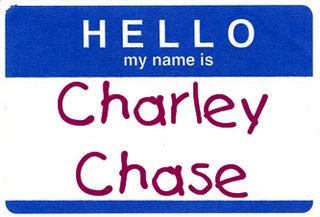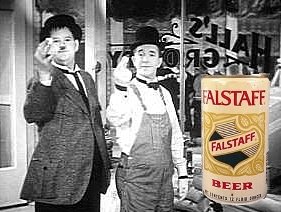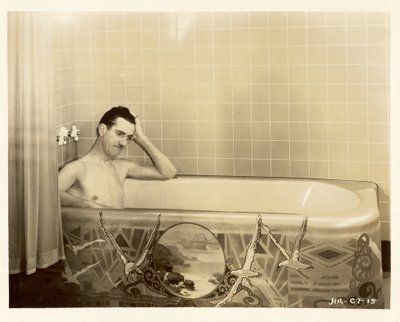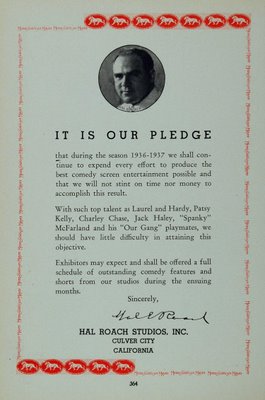
The word “hooter” used to mean “nose.” Somehow its position in anatomy slipped.
Pay no attention to the “ie” at the end of Charley Chase’s name in the lobby card above. His name, at the time he made “The Grand Hooter” was then, is now, and forever shall be Charley, C-h-a-r-l-e-y, as in “Charley, My Boy.” Yes, even Columbia Pictures occasionally misspelled his name.
 And it’s Charley’s good name I’m here to talk about.
And it’s Charley’s good name I’m here to talk about.
Lets take a step back.
What’s your reaction when some despicable crime, committed by some unknown individual, galvanizes the nation?
Depending on the nature of the crime, you’ll register sympathy, empathy, anger, despair, and/or incredulity. You’ll ask what this country’s coming to, and if it’s really come to this, when something like what happened can happen. If there’s a minority, religion, political party, geographic area or identifiable group you despise, you’ll be tempted to assign blame (“This is how Pilates and soy milk are destroying the fabric of America.”)
Personally, I skip all that stuff and focus on one thing only in a “major new crime” situation: Will the criminal, once discovered, share my name or any part of it? Because I’d surely have to change names immediately were that the case.
What do you imagine all the Lee Oswalds of the world were doing on Monday morning, November 25, 1963? Thinking up new names as they pushed people aside in their fervent effort to reach city hall.
Ironically, fear of this possibility has been nameless. Sigmund Freud had a name for it, though: nominidemophobia, from the Latin for “same name fear.” The name has not been widely adopted, perhaps because this was the Sigmund Freud who played utility infield Triple A ball for the Portland Beavers in the late 1980’s. Others have suggested that the inherent unpronounceability of nominidemophobia may be to blame.
Nonetheless, many of us suffer from nominidemphobia, which is the primary reason media coverage of assassins has always included the middle name. It is for the sake of all the Bruno Hauptmans with middle names other than Richard and the sake of all John Booths who are not Wilkses that middle names are a must.
You doubt that? WhitePages.com has 146 people named John Booth, including the Jons, the Johnnies, the Jonathans and the Jacks.
Not one of them – not one – has “W” as their middle initial.
While it’s true that there is a general paucity of “W” middle names due to the letter’s close association with our soon to be ex-president, most nominologists maintain that nearly all the “W” aversion seen in the current crop of John Booths remains powered exclusively by a single 1865 event.
 It may be true that, as Stan says to Ollie in Tit For Tat (a possible future Charley Chase film title; see below), “He who filters your good name steals trash.”
It may be true that, as Stan says to Ollie in Tit For Tat (a possible future Charley Chase film title; see below), “He who filters your good name steals trash.”
Shakespeare’s Falstaff is the source of the original quote, “He who steals my good name, steals all that I have.” (Falstaff’s name was later stolen by a beer.)
And now, trash has stolen Charley Chase’s good name, and you need a filter - specifically, Google’s SafeSearch filter – when you perform a search on his name.
Below is a rare photo of Charley Chase without clothes, from the 1932 two-reel Hal Roach comedy In Walked Charley. This is not the reason you need SafeSearch.

Below is a rare photo of Charley Chase with clothes, publicity from or for an unknown production. This is not the reason you need SafeSearch.

It’s all the other pictures of the Charley Chase seen immediately above, 99% of which are NSFW.
Were the latest Charley Chase an actress, she’d have to join The Screen Actor’s Guild, which frowns upon name-cloning:
It is the Guild’s objective that no member use a professional name which is the same as, or resembles so closely as to tend to be confused with,the name of any other member. The Guild urges all applicants and members to minimize any personal or individual risk of liability by avoiding a name that may cause confusion. (Guild Rule 15).
It reads like a guideline, but it works like a rule:
- Michael J. Fox added the “J” because there was already a Michael Fox who was a member of SAG.
- Michael Caine (Maurice Micklewhite) originally chose the name “Michael Scott” for himself, but had to give it up because there already was an actor named Michael Scott.
- Actress Emma Stansfield was born Emma Thomson. Since there was an Emma Thompson, she had to change her name.
- Ditto Michael Douglas, whose name had already been registered by the other Michael Douglas, so Michael Douglas became Michael Keaton.
- Diane Hall’s name had been previously registered, so she became Diane Keaton, thus making Keaton the go-to name for people facing this problem.
Civilians who want to slipstream behind a famous name are rarely stopped from doing so: Jesus Christ lives in Washington Heights and Santa Claus calls Utah home. Andy Griffith ran for Sheriff and was sued by Andy Griffith. (Andy Griffith won, that sure tells you nothing!)
And I, for one, am proud to live in a country where Paul Simon becomes a U.S. Senator, Jerry Lewis is elected to congress, and Albert Einstein does stand-up comedy (as Albert Brooks).
Let’s cut to the Chases.
In an effort to stem future confusion, allow me to point out that despite evidence to the contrary, the films listed below are actual comedies featuring Charley Chase rather than “adult entertainment” featuring Charley Chase:
- Position Wanted (1924)
- Bungalow Boobs (1924)
- All Wet (1924)
- The Way Of All Pants (1927)
- Limousine Love (1928)
- Looser Than Loose (1930)
- The Grand Hooter (1937)
- The Big Squirt (1937)
As you may or may not know, this blog got its name from a silent Charley Chase comedy which, once again, seems appropriate:

